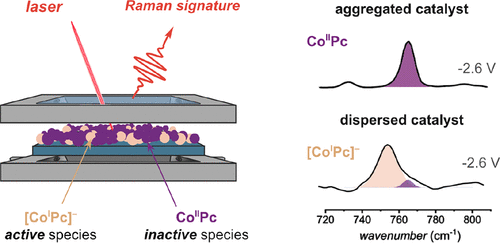Catalyst Aggregation Matters for Immobilized Molecular CO2RR Electrocatalysts
Catalyst Aggregation Matters for Immobilized Molecular CO2RR Electrocatalysts
Here, we detail how the catalytic behavior of immobilized molecular electrocatalysts for the CO2 reduction reaction (CO2RR) can be impacted by catalyst aggregation. Operando Raman spectroscopy was used to study the CO2RR mediated by a layer of cobalt phthalocyanine (CoPc) immobilized on the cathode of an electrochemical flow reactor. We demonstrate that during electrolysis, the oxidation state of CoPc in the catalyst layer is dependent upon the degree of catalyst aggregation. Our data indicate that immobilized molecular catalysts must be dispersed on conductive supports to mitigate the formation of aggregates and produce meaningful performance data. We leveraged insights from this mechanistic study to engineer an improved CO-forming immobilized molecular catalyst─cobalt octaethoxyphthalocyanine (EtO8–CoPc)─that exhibited high selectivity (FECO ≥ 95%), high partial current density (JCO ≥ 300 mA/cm2), and high durability (ΔFECO < 0.1%/h at 150 mA/cm2) in a flow cell. This work demonstrates how to accurately identify CO2RR active species of molecular catalysts using operando Raman spectroscopy and how to use this information to implement improved molecular electrocatalysts into flow cells. This work also shows that the active site of CoPc during CO2RR catalysis in a flow cell is the metal center.


